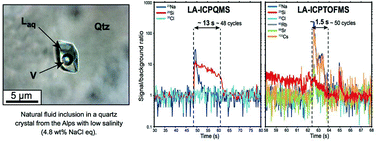Capabilities of sequential and quasi-simultaneous LA-ICPMS for the multi-element analysis of small quantity of liquids (pl to nl): insights from fluid inclusion analysis
Abstract
Three configurations of inductively coupled plasma mass spectrometers (ICPMS), namely: a quadrupole (QMS) and a sector-field (SFMS), both equipped with a standard cylindrical ablation cell, and an orthogonal time-of-flight (TOFMS), equipped with a fast washout ablation cell, were coupled with the same 193 nm Excimer laser ablation system in order to evaluate their capabilities for measurement of multiple minor and trace elements in small quantities of liquids (pl to nl), such as fluid inclusions. Analyses were performed with different objects: (i) multi-element solutions sealed in silica capillaries of internal diameter of 20 μm serving as synthetic analogues of natural fluid inclusions; (ii) natural two-phase (liquid + vapour) fluid inclusions with low salinity (ca. 4.8 wt% NaCl eq.) and homogeneous compositions, trapped in quartz crystals from the Alps; (iii) natural multi-phase (liquid + vapour + multiple solids) fluid inclusions with high salinity (ca. 13–15 wt% NaCl eq.) and homogeneous compositions, trapped in quartz crystals from the Zambian Copperbelt. This study demonstrates that the SFMS and TOFMS provide improvements, particularly in term of limits of detection (LODs) and precision, compared to the QMS traditionally used for the measurement of fluid inclusions. SFMS leads on average to lower LODs within one order of magnitude compared to QMS and TOFMS, but precision and accuracy are lower due to longer acquisition cycle times. TOFMS presents both advantages of having rapid and quasi-simultaneous acquisition for all isotopes from 6Li to 238U in a very short cycle time down to 30 μs, with higher precisions and lower LODs than for QMS for isotopes with m/Q > 11. Its use, coupled to a fast washout cell, leads to (i) the improvement in the analysis of small-size (<10 μm) and multi-phase fluid inclusions and (ii) detection of higher number of isotopes compared to QMS and SFMS, which are both limited by the number of measured isotopes from short transient signals of fluid inclusions. Consequently, the tested TOFMS, coupled with a fast washout ablation cell, appears to be a promising instrument for the analysis of natural fluid inclusions by LA-ICPMS, especially for small, multi-phase and/or low salinity fluid inclusions.


 Please wait while we load your content...
Please wait while we load your content...